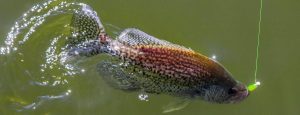Crappie fishing success often hinges on understanding how these fish perceive their environment. While crappie lack visible ears, their ability to detect sound and vibration plays a vital role in locating prey and evading predators. Learn how crappie use sound, when it matters most in fishing, and how to optimize techniques to either minimize or enhance noise for better results.

How Crappie Detect Sound
Crappie rely on otoliths—bone structures in their ears—and lateral lines along their bodies to perceive vibrations and sound waves. These mechanisms allow them to sense their surroundings effectively, even in murky water. Anglers familiar with the importance of stealth often overlook how strategic sound can attract crappie or prompt a strike.
Knowing When Sound Matters
Legendary crappie angler Whitey Outlaw has spent decades perfecting sound-related techniques. He emphasizes that noise can work both for and against an angler, depending on the situation:
- Structure-Oriented Crappie
Fish committed to structure such as vegetation or cypress trees are less likely to be scared off by sudden sounds. Outlaw often approaches grass beds directly with his outboard running, creates a small opening, and drops his jig in without alarming the fish. - Suspended Crappie in Open Water
Conversely, in shallow, cover-less waters, excessive noise from boats or electronics can spook fish. During a Crappie Masters tournament, Outlaw and his partner minimized boat noise and turned off electronics, resulting in a winning catch.
Quiet Techniques for Stealthy Fishing
Reducing noise is crucial when crappie are pressured. Outlaw shares practical tips for keeping things quiet:
- Load the Boat
Adding weight to the bow can reduce noise caused by waves slapping against the hull. Sandbags or extra batteries are effective solutions. - Use Wind Strategically
Drifting with the wind instead of against it minimizes wave noise and trolling motor use. Employing wind socks further stabilizes the boat for a quieter approach. - Add a Bow Silencer
Products like the Silent Stalker attach to the bow to dampen wave noise, especially for aluminum boats. - Turn Off Electronics
High-wattage electronics can alert crappie. Shutting down sonar and aerators can make a significant difference in pressured waters.
Making Noise Work in Your Favor
At times, sound can be a powerful attractant. Outlaw highlights techniques to make the right kind of noise:
- Rattling Jig Heads
Products like the Rockport Rattler produce vibrations that draw crappie, even in less aggressive moods. By shaking or bouncing the jig, anglers can provoke strikes, particularly in muddy conditions. - Insertable Rattles
Soft plastics equipped with insertable rattles, such as those from Bobby Garland, can amplify noise without requiring jig heads, making them ideal for double-minnow rigs.
Simplifying with the Right Gear
Outlaw’s choice of rods reflects his philosophy of simplicity and efficiency. The Whitey Outlaw Santee Elite rod, designed for vertical jigging in heavy cover, features a streamlined design that prevents snags and enhances usability.
Sound plays an indispensable role in crappie fishing, whether it’s about minimizing noise to avoid spooking fish or leveraging vibrations to attract them. By understanding when and how sound matters, anglers can elevate their techniques and bring more crappie to the boat.
Image/Source: Wired2Fish





